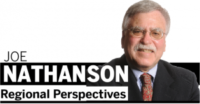
Imagine a city with nearly a dozen miles of green ribbons of land bordering local waterways. Then imagine that these stretches of shoreline include trails to accommodate walkers, joggers, scooters and cyclists. Further imagine that these trails have more connecting paths that bring you to neighborhood parks, outdoor recreation spaces, and picnic areas, as well as linking you to the adjoining city neighborhoods.
That city could be Baltimore, as current plans move forward in the effort to Reimagine Middle Branch. That refers to the master plan recently adopted unanimously by the Baltimore Planning Commission to enhance 11 miles of the Middle Branch of the Patapsco River as it winds its way through South Baltimore. The initiative is intended to transform 19 neighborhoods adjoining the waterway from Brooklyn and Curtis Bay in the south to Pigtown and Barre Circle to the north.
Recently I heard a presentation by Ethan Cohen, who serves as senior adviser, economic and community development, in the office of Baltimore Mayor Brandon Scott. The setting of the meeting was itself an eye-opener. The new Middle Branch Fitness and Wellness Center, on Reedbird Avenue adjacent to the Cherry Hill neighborhood, was bustling with activity. It seemed that every available exercise bicycle and other piece of cardio equipment was in use. The 35,000 square-feet facility, opened in November, also features three indoor swimming pools, a gymnasium with a basketball court, classrooms, a maker space, and a room for community meetings.
This $23.1 million investment was accomplished with funding from the city, state, and about $2 million from the South Baltimore Gateway Partnership (SBGP). The partnership is the authority established to receive and manage that portion of the stream of revenue from video lottery terminals and designated for casino-Impacted communities. Currently the casino funding generates an estimated $8 million to $9 million annually.
The presentation made clear that the fitness center was just the beginning of things to benefit the neighborhood. Nearby, construction of three multipurpose athletic fields is underway, and a lighted football field is ready to host teams.
The entire complex will be connected to the Gwynns Falls trail and other components of the trail network. One of those is the African-American heritage trail that will link up historic sites, including Mount Auburn cemetery and the one-time location of Black Sox field, where the Negro League baseball club played its home games. A commemoration of the team could be accompanied by a new little league playing field.
We also had a chance to view a video that highlighted future amenities, priorities identified by local residents. Among them is a new and expanded boathouse and a sandy beach to support canoeing and kayaking; a new marina for sailing out of Smith Cove; an event pavilion for community gatherings and celebrations; and a marketplace where community members might display their crafts, along with a nearby food concession.
Major roadways, including the Vietnam Veterans Memorial Bridge and the Hanover and Potee street bridges, would be redesigned using a “complete streets” approach, to safely accommodate bikes and pedestrians as well as auto traffic.
I spoke with Brad Rogers, the executive director of SBGP, to get a sense of the next major push to bring change to the area. He was quick to mention nearly $48 million in new grant funding, including a $32 million grant from FEMA to create resilient shorelines.
From SBGP’s transformational projects manager, Ethan Abbott, I learned about the Middle Branch Resiliency Initiative which will be using treated dredge material from the Maryland Port Administration to create these new wetlands that will feature native plant life, attract waterfowl, improve water quality and mitigate against flooding and sea rise.
Prime early targets for this resiliency treatment include sites adjacent to MedStar Harbor Hospital and the area around BGE’s Spring Garden property in Westport. Future additions can be expected further north along the Westport waterfront near the stadiums and the newly developed Entertainment District.
I asked Rogers how he responds to skeptics who might see the grand plans and myriad commitments to the residents of the South Baltimore communities and express doubts that they will be realized. He points to the fact that $175 million has already been or soon will be deployed to move the many projects along. People are seeing the results.
Finally, Rogers let me know that in the next few weeks there will be a big announcement regarding major new programs to support the communities through real estate investments. We’ll stay tuned.
_________________________________________________________________________
Joe Nathanson is the retired principal of Urban Information Associates, a Baltimore-based economic and community development consulting firm. He can be contacted at [email protected].